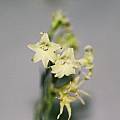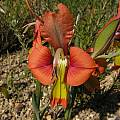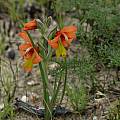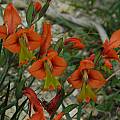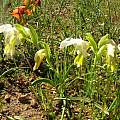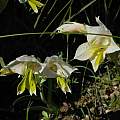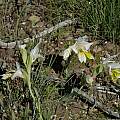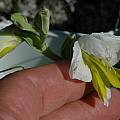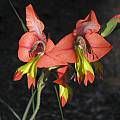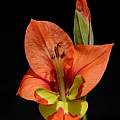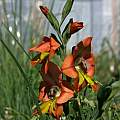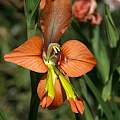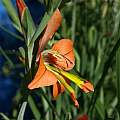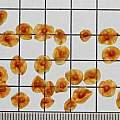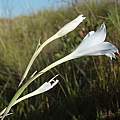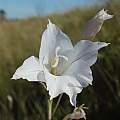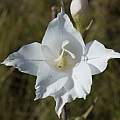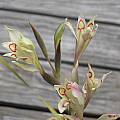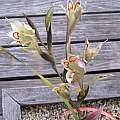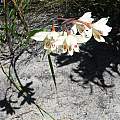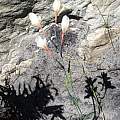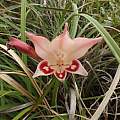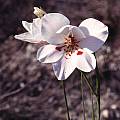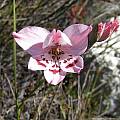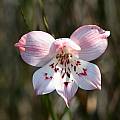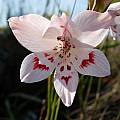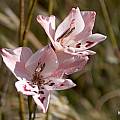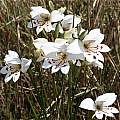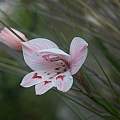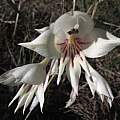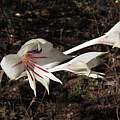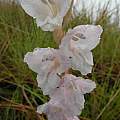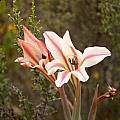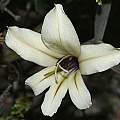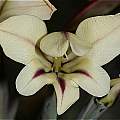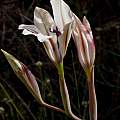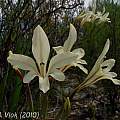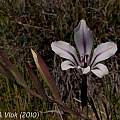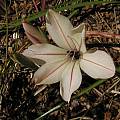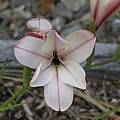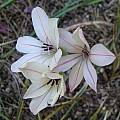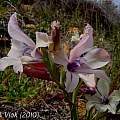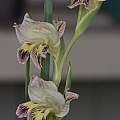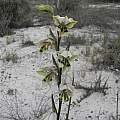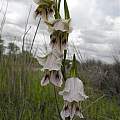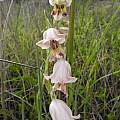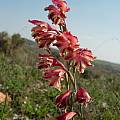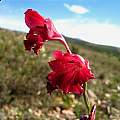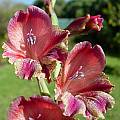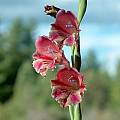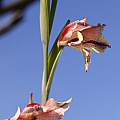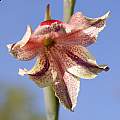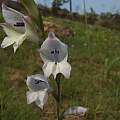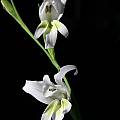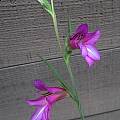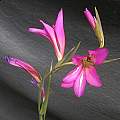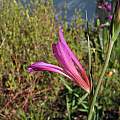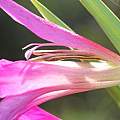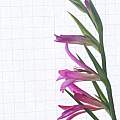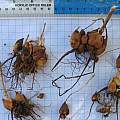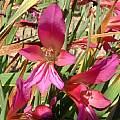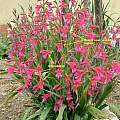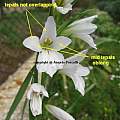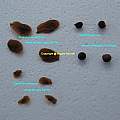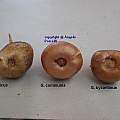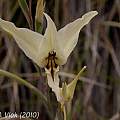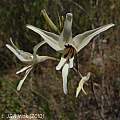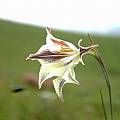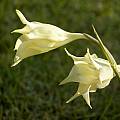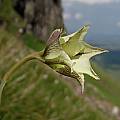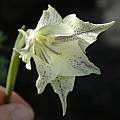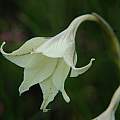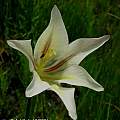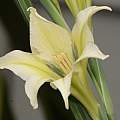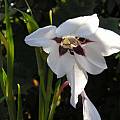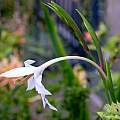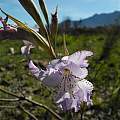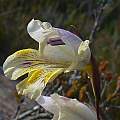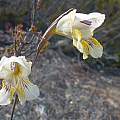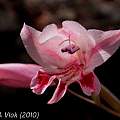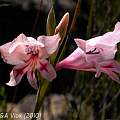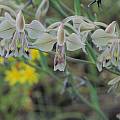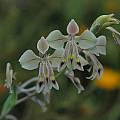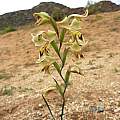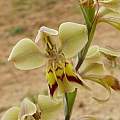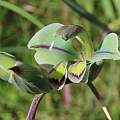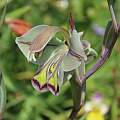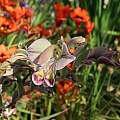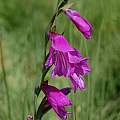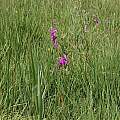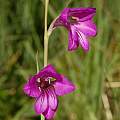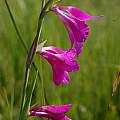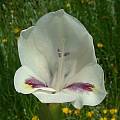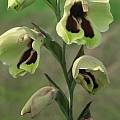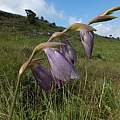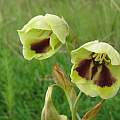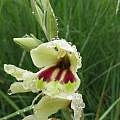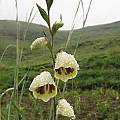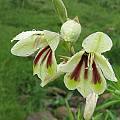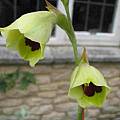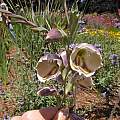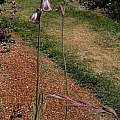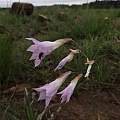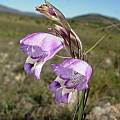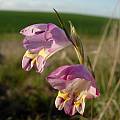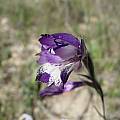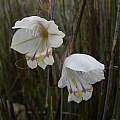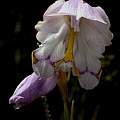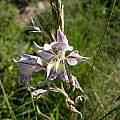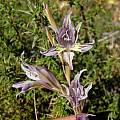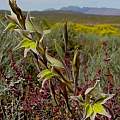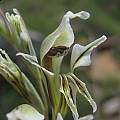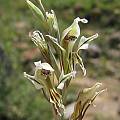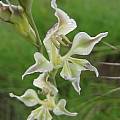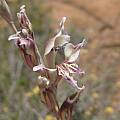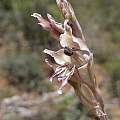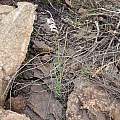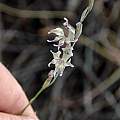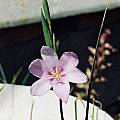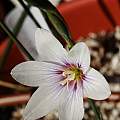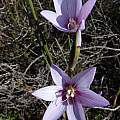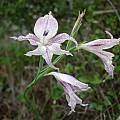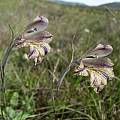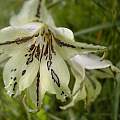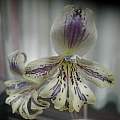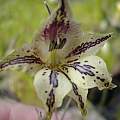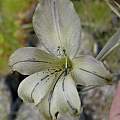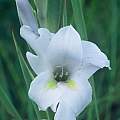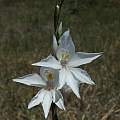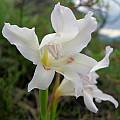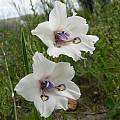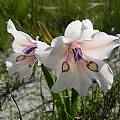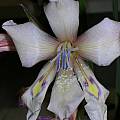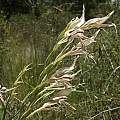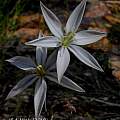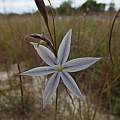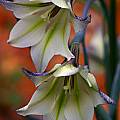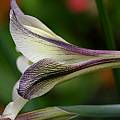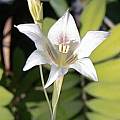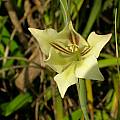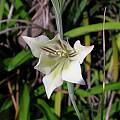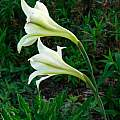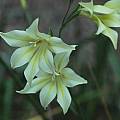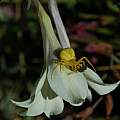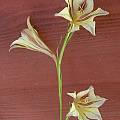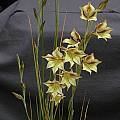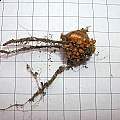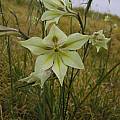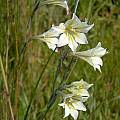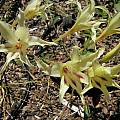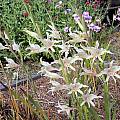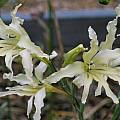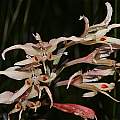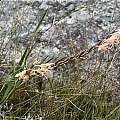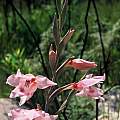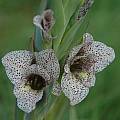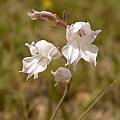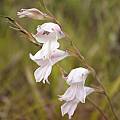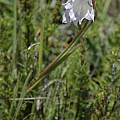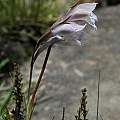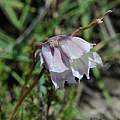These colors are often associated with moth pollination, and so some of the most fragrant Gladiolus can be found in this category. Another big group in this category are those species who have occasionally some kind of albino form - rare in nature, but eagerly adopted by gardeners when found.
Gladiolus acuminatus F.Bolus is an endangered species known from no more than five locations. It is endemic to the Overberg, where it grows in stony shale on flats and in renosterveld. It has a long perianth tube and pale greenish cream fragrant flowers. Photo by Alan Horstmann.
Gladiolus alatus L. is a winter rainfall species found on flats, slopes, and plateaus, mainly in sand. The flowers are orange, marked yellow and have a light and pleasant scent. Photo 1 was taken near Paarl September 2003 by Bob Rutemoeller. The next two pictures were taken by Bob Rutemoeller and Mary Sue Ittner near Bainskloof September 2006.
Photos below are a white form of this species. The first photo was taken by Alan Horstmann. The next two photos from Mary Sue Ittner and Bob Rutemoeller were taken near Villiersdorp. The last photo by Bob Rutemoeller shows a white form for sale in a nursery in Caledon.
The photos below are of plants in cultivation. Photo 1 by Mary Sue Ittner shows flowers on a plant grown from seed blooming March 2005. Photo 3 from Bob Werra. Photos 3-6 were taken by Nhu Nguyen. Photo 5 show seeds on a 1 cm square grid.
Gladiolus albens Goldblatt & J.C.Manning, syn. Gladiolus maculatus Sweet ssp. eburneus Oberm., is a narrow endemic of the Eastern Cape where it is found on grassy slopes and in fynbos type vegetation on light well drained soils. Although it grows primarily in a summer rainfall zone, the area where it grows does get some winter rainfall and this species flowers in the fall in April and May and has its main growth in winter after flowering. Plants are generally 25 to 50 cm high and the flowering spike has 1 to 3, rarely to 5, flowers. Flowers are white to cream, sometimes with faint speckles or streaks in the throat or all over the tepals, with a long slender perianth tube (35-50 mm) that expands in the upper part and have a dusty sweet scent. Photos taken by Rachel Saunders in the Eastern Cape.
Gladiolus angustus L. is found in wet places on sandstone soils in the southwestern corner of the southern African winter-rainfall region. Growing from 60 to 120 cm high, it flowers in spring (October and November) with cream to pale yellow flowers with diamond spade shaped yellow markings outlined in dark red on the lower tepals. The species has a very long perianth tube, usually 7 to 10 cm, and the lower tepals are substantially shorter than the upper tepals. It is related to Gladiolus carneus and Gladiolus undulatus. The first two photos from Mary Sue Ittner. The next two photos from iNaturalist taken by Chris Vynbos and shared under a CC BY-SA license. The last photo from Rachel Saunders.
Gladiolus appendiculatus G.J.Lewis is native to the Northern Provinces, South Africa and Swaziland where it grows in grassland on mountain slopes usually above 1800 m up to 2100 m. Growing from 35 to 60 cm, it has softly leathery 6 to 9 long leaves tapering to a sharp or blunt tip and 6 to 14 white to pink unscented flowers marked mauve or pink in the lower tepals, borne on one side. The tepals are unequal in size with the upper three largest and the dorsal arching over the stamens. Anthers have long tails. Flowering occurs in April and May. Photo from Rachel Saunders.
Gladiolus debilis Ker Gawler is found on rocky sandstone slopes in the southwest Cape, blooming in spring with white to pale pink flowers with red markings on the lower tepals. The first photo by Mary Sue Ittner was taken in September 2001 in an area in the southwest Cape that had burned the year previously and the second was taken by Bob Rutemoeller September 2003 at Boskloof. The third was taken by Ragnhild Crawford. Photos four and five taken near Napier in the Overberg by Cameron McMaster. The sixth photo was taken by Andrew Harvie at Silvermine in Table Mountain National Park. Last photo by Christopher Whitehouse, taken at the Phillpskop Mountain Reserve near Stanford.
Gladiolus engysiphon G.J.Lewis is found in clay and granitic loam in renosterveld and grassland in the Langeberg Center (Swellendam to Mossel Bay). Growing from 35 to 50 cm high, it flowers March to April. The cream flowers with red median streaks are arranged in a 2 to 6 flowered spike. Photos taken by Rogan Roth in the southern Cape in April 2021. He first thought it was Gladiolus bilineatus which has a similar flower, distribution, and flowering time in the autumn. Both are pollinated by a species of long-proboscid fly. According to John Manning the lowest leaf in Gladiolus bilineatus always develops a short, sword-shaped blade, whereas the leaf blades in Gladiolus engysiphon are either absent entirely or needle-like. The arrangement of the leaves and the diameter of the stem is also different in the two species.
Gladiolus ferrugineus Goldblatt & J.C.Manning grows in marshy grassland or well watered stony slopes in the summer rainfall area in eastern Southern Africa from the Northern Province to North Swaziland. Growing from 35-60 cm, it has 6-8 channeled leaves with the largest leaves twisted, and small white to pink short tubed flowers with rust colored bracts. The lower lateral tepals have cream to pale yellow blotches in the midline. There are two distinct forms. The form from the lower escarpment flowers in summer from late November to early February and has broader leaves and shorter tubes and the form from the upper escarpment flowers in autumn (March and April) and has narrower leaves with thickened margins and twisted blades and longer tubes. Photo from Rachel Saunders.
Gladiolus floribundus Jacq. grows on dry clay, sandy or limestone flats and slopes over a broad area of the winter rainfall Cape. It has white to cream or pinkish flowers with a dark median streak on all of the tepals and blooms in late spring. The first two photos taken by Cameron McMaster near Napier in the Overberg. Photos three, four, and five were taken by Andrew Harvie. Photo three was also taken in the Overberg in the De Hoop Nature Reserve. The last two were taken on a a rocky ridge top in the Swartberg Mountains.
Photos below from the book Plants of the Klein Karoo courtesy of Jan and Anne Lise Schutte-Vlok who write that this species grows up to 60 cm tall with broad grey green leaves. It can be confused with Gladiolus grandiflorus which has a shorter tube.
Gladiolus grandiflorus Andrews grows on clay slopes in the renosterveld in areas with winter rainfall and some year round rainfall. Growing from 25 to 50 cm, it has sword shaped leaves with thickened margins and midrib and cream to greenish flowers in a two to nine flowered spike, sometimes with a darker median streak on lower or all the tepals. If flowers September to October. Photos 1-3 by Mary Sue Ittner of plants grown from seed that had creamy white flowers marked in red and flowered late April, early May each year in her Northern California garden. Photo 4 taken by Bob Rutemoeller at Bontebok National Park September 2003. The last photo below from the book Plants of the Klein Karoo courtesy of Jan and Anne Lise Schutte-Vlok.
Gladiolus griseus Goldblatt & J.C.Manning grows in calcareous sand and limestone soils right near the sea, all up the southwest coast to Saldanha. The total wild population of this species is estimated to be less than 250 plants. There are 3 to usually 6 to 15 small mauve to grey flowers with a yellow band across the upper third of the lower tepals edged in green and maroon. The dorsal tepal arches over the stamens and the lower narrow tepals are directed forward. The flowers are lightly fragrant and bee pollinated. This species is closely related to Gladiolus carinatus and sometimes difficult to distinguish from it. Bloom time is different as this species blooms earlier in winter (May to July). The flowers are also smaller and unbranched with the upper tepals arched forward and there are usually more flowers on a spike. The first two photos from Arnold Trachtenberg. The last three photos taken June 2011 by Rachel Saunders on the southwest Coast shows the variation in different plants.
Gladiolus guthriei F.Bolus is a winter-growing species that occurs on rocky sandstone outcrops in the Western Cape. It incorporates plants formerly known as Gladiolus odoratus L.Bolus. It blooms in fall to early winter; April to June in its native range. Plants that will bloom send up a flowering stalk with very short leaf stubs on it. Plants not blooming in that year produce a long leathery leaf. The flowers generally have a pale yellow or straw base color, liberally decorated with mauve or dark magenta streaks and freckles. The result looks fairly dull from a distance, but the flowers reward close examination. They have a sweet scent. First four photos taken in Napier and Villiersdorp in the Overberg by Cameron McMaster. The fourth and fifth photos are of the Gladiolus odoratus form, blooming in December in California by Michael Mace.
Gladiolus inandensis Baker is a species that grows in small clumps to 20 to 45 cm. It is mostly found on sandstone soils in KwaZulu-Natal and the Eastern Cape, but it also has been recorded in Lesotho. Plants are found on rocky grassland and flower early in the summer rainfall region, mostly July to August, extending into September. This species has small white to cream flowers flushed with purple on the outside of the tepals. The dorsal tepal is hooded over the stamens. This species is unusual in that the flowers are usually produced before the new leaves on short stems with the dry dead previous foliage leaves attached to their base. This species is very similar to Gladiolus wilsonii but that species produces a stem after the new leaves are produced and flowers at a different time. Photo from Rachel Saunders.
Gladiolus involutus D.Delaroche is found on clay slopes in renosterveld and grassland in areas with summer and winter rainfall. Flowering from winter into spring, it has white flowers with yellow-green markings on the lower tepals. Photo by Bob Werra.
Gladiolus italicus has a broad distribution from southern Europe to parts of Asia growing on rocky hillsides, grassy areas, open forests and in fields. It flowers from March to July. Theophrastus wrote that the corm when pounded and mixed with flour made bread sweeter. It is distinguished from other European Gladiolus by having anthers that are longer than the filaments. Flowers are loosely arranged and facing various directions, pale pink as well as purple-pink to magenta with a pale blotch outlined in purple on the lower lobes. There are 5 to 15 flowers on the spike. Photos 1-2 taken by Mary Sue Ittner show the flowers of a plant grown from seed labeled G. italicus. Photo 3 was taken by Nhu Nguyen. Photos 4-6 by M. Gastil-Buhl include a close-up showing the relative length of anthers and stigma, a flower spike and corms still in the clusters as found when excavated against a 1 cm grid. The corms were found growing between 3 to 5 inches deep, including layers of added compost and grit. All of these corms and more grew in 2 years from just 4 juvenile corms.
Photos from Angelo Porcelli. The first is a close-up taken in habitat. The last three photos were taken from his article Gladiolus of Southern Italy. In this article he explains the difference between this species and Gladiolus byzantinus and Gladiolus communis. Gladiolus italicus is smaller, averaging 20 to 23 inches (50-60 cm) and has flowers with an "open" shape; the lateral tepals are oblong, narrow and well spaced, not overlapping the upper tepal and the two lower ones. Seed is quite different in this species from the other two which have winged seed. Seed looks like small pepper grains with three to four angles. Corms have a peculiar net on the tunics, especially on the top of the corm, and are a rather light brown color. This species is highly bulbilliferous and increases by cormlets at an alarming rate and a single corm will turn in a clump in a few years.
Gladiolus leptosiphon F. Bolus is an uncommon species from South Africa that occurs from Ladismith in the Little Karoo to Uitenhage in the Eastern Cape where it is found on stony hills and low mountain slopes in renosterveld or arid fynbos. It is threatened by ongoing habitat loss to agricultural expansion, particularly ostrich farming but also crop cultivation. Plants grow up to 60 cm tall with narrow whip like leaves and 6-9 creamy white flowers marked with dark red-purple lines on the lower three tepals and a long slender tube. The upper three tepals are largest, the dorsal suberect and the lower tepals narrow, channeled, arching downward. Flowering is in spring (October to November). Pollination is by a long-tongued fly. Photos from the book Plants of the Klein Karoo courtesy of Jan and Anne Lise Schutte-Vlok.
Gladiolus longicollis Baker is a species found in a wide area of southern Africa, including the southern Cape, the eastern Cape, the Free State and the Northern Province. It has pale yellow to white long tubed flowers that are either uniformly colored or mottled with brown. Flowers are night blooming and sweetly scented of carnation and cloves. There are two subspecies:
Gladiolus longicollis ssp. longicollis has a shorter perianth tube and transparent upper tepals and flowers October to November. It is found from Oudtshoorn in the Western Cape through the Eastern Cape and Free State and into Lesotho and Gauteng where it usually grows on moist, south facing slopes in low grassy fynbos or rocky grassland.
Gladiolus longicollis ssp. platypetalus (Baker) Goldblatt & J.C.Manning has a longer perianth tube and broader petals with the outer whorl tepals longer than the inner whorl and grows in rocky grasslands from central KwaZulu-Natal to Mpumalanga and Limpopo. Its flowering season extends into January and possibly February.
The first three photos from Cameron McMaster and the next two from Mary Sue Ittner. Photos three thru five were taken at Naude's Nek.
The first photo from the book Plants of the Klein Karoo courtesy of Jan and Anne Lise Schutte-Vlok. They describe it as growing up to 60 cm tall with narrow cylindrical leaves and flowers with red brown spots and lines. The anthers are not much exposed, a characteristic that helps distinguish it from a similar looking Gladiolus tristis. The second photo is from Arnold Trachtenberg.
Gladiolus murielae syn. Acidanthera bicolor , Gladiolus callianthus , and Acidanthera murielae is a species with a wide distribution from northeastern Africa southward to Mozambique. It is often sold or described under the Acidanthera synonyms or, as it is most common in northern Ethiopia, sometimes called Abyssinian gladiolus. This species has long tubed white flowers with dark purple markings in the midline on the lower tepals or all tepals and is fragrant, more strongly at night. Since it comes from a tropical climate, it is often protected in colder climates and dug in the winter and stored and replanted after the last frost so that it will be summer growing, blooming late summer into fall. Photo 1 by Arnold Trachtenberg of plants blooming in the Brooklyn Botanical Garden, Photo 2 by Martin Bohnet illustrates the length of the tube.
Gladiolus mutabilis is an Eastern Cape species and also occurs in the eastern part of the Western Cape. Plants grow in sandstone derived soils. This species has slightly fleshy leaf blades without thickened margins or midribs and an elongated corm that is two to three times as long as wide. Flower color ranges from pale to dark blue, mauve, brown or cream. The lower tepals are usually cream or yellow below with dark blue or brown dots and streaks on the yellow background forming the nectar guide. The fragrant flowers appear early in the season, June or July. The first photo was taken by Rachel Saunders who discovered this plant late July 2012 blooming in an area that had previously burned in the Western Cape. The next two photos were taken by Cameron McMaster August 2012 at the top of Potjiesberg Pass south of Uniondale (Eastern Cape) where it was growing with Gladiolus patersoniae. In the Western Cape population Gladiolus patersoniae was also in flower raising the question of whether they are both pollinated by the same pollinator. The last photo from the book Plants of the Klein Karoo courtesy of Jan and Anne Lise Schutte-Vlok.
Gladiolus nigromontanus Goldblatt is a rare South African species that occurs only on rocky outcrops on sandstone slopes in the Swartberg Mountains. Flowering in autumn (March) and best a few years after a fire, it grows to 30 cm with narrow leaves and small white long tubed flowers suffused light pink and marked with red and yellow on the three lower lobes. Flowers are in a 3 to 6 flower spike. Photos from the book Plants of the Klein Karoo courtesy of Jan and Anne Lise Schutte-Vlok.
Gladiolus orchidiflorus Andrews is found on clay and sandstone soils from Namibia to Cape Flats and also to Free State and flowers in the spring. It has linear to sword-shaped leaves that are thickened in the midline. Flowers are in a 5 to 12 flowered spike, windowed in profile, greenish to purple with dark purple markings on the lower tepals, and are very fragrant. Photos 1-2 are habitat shots taken in Namaqualand by Bob Rutemoeller and Mary Sue Ittner September 2006. Photos 3-4 were taken near Carolusberg, Namaqualand by Cameron McMaster September 2011.
The photos below were taken by Alan Horstmann.
Gladiolus ornatus Klatt is found on marshy sandstone and granite slopes in the Southwestern Cape, South Africa. Growing from 25 to 35 cm high, it has linear leaves and pink unscented flowers in a funnel shaped tube in a one to three flowered spike. The lower tepals each have a spear to spade shaped white median streak edged in dark pink and the lower part of the throat is white streaked with dark pink. Flowering is from September to November. Photo by Rachel Saunders.
Gladiolus palustris Gaudin is native to central and northwestern Europe, the most northerly range in the genus, and is suitable for ordinary to moist border conditions, as well as a bog garden. The normal flower color is rosy violet. Photos 1-4 from Hans Joschko. The pictured white form in photo 5 from Jane McGary was grown from seed sent by Ole Olsen of Norway, who cultivates the parent plants as a "blue" form. This species faces only one direction and does not have more than 6 flowers on a spike. We have been told this may be misnamed, but have not been given another name.
Gladiolus papilio Hook.f. (syn. G. purpureo-auratus, G. brachyscyphus, G. spathulatus, G. schlechteri) is called the Butterfly Gladiolus, and grows in marshy ground, up to 2400 m, from the Eastern Cape to Limpopo Province. It is claimed to be a hardy garden plant, grown in the UK since 1866. The first two photos were taken by Roy Herold in KwaZulu-Natal Province, near Kamberg in the foothills of the Drakensberg, in early December 2006. The third was taken by Rod Saunders. The fourth, an unusual color form, was taken by Rachel Saunders in the mountains above Tzaneen, early January 2015.
The photos below were taken by Cameron McMaster in Lesotho.
The first photo from John Grimshaw is of a form he labels in the "purpureoauratus" group. The second and third photos were taken by Bob Rutemoeller in the Mendocino Coast Botanical Gardens.
Gladiolus parvulus Schltr. is restricted to the southern half of KwaZulu-Natal, South Africa, into Lesotho where it grows in thin soil on sandstone pavements or in cracks in sandstone outcrops at elevations up to 3300 m. Growing from 15 to 35 cm, it has two leaves, the larger sheathing the stem and the second a small bract-like leaf immediately below the lowest flower. It has small horizontal to almost nodding light pink flowers with equal tepals. The flowers have been described as looking more like an Ixia or a Dierama. It flowers October to early December. Photo from Rachel Saunders.
Gladiolus patersoniae is widespread in the southern African winter rainfall areas. It occurs in exposed rocky habitats in the interior ranges of the Cape Floral region, but also near the coast at Cape Infanta and on stony alluvial flats near Worcester. It grows on soils derived from sandstone. Plants grow to 50 cm and have narrow cylindrical leaves. The bell like short tubed and sweetly scented (similar to apple and carnation) pale to deep blue, slate, grey or cream flowers are pollinated by long tongued bees. The lower three tepals have a transverse yellow band usually outlined in dark blue or purple. Flowering occurs in late winter to spring, earlier at lower elevations. The first five photos by Cameron McMaster. His last one was taken August 2012 at the top of Potjiesberg Pass south of Uniondale (Eastern Cape) where it was growing with Gladiolus mutabilis. The last photo from the book Plants of the Klein Karoo courtesy of Jan and Anne Lise Schutte-Vlok.
Gladiolus permeabilis D.Delaroche grows on shale slopes in renosterveld from Caledon east through southern Africa and to Zimbabwe. In the Cape province it blooms late winter into spring. Usually 20 to 30 cm tall, but can be up to 50 cm, it has flat narrow leaves with a prominent midrib and mauve to dull purple or cream flowers with yellowish makings. Flowers are usually intensely fragrant. The first photo was taken by Cameron McMaster in the Overberg and the second by Bob Rutemoeller in the Bontebok National Park. The last photo below from the book Plants of the Klein Karoo courtesy of Jan and Anne Lise Schutte-Vlok
Gladiolus permeabilis ssp. edulis (Burch. ex Ker Gawl.) Oberm., syn. Gladiolus edulis, is widespread across the summer-rainfall zone and is common in the drier areas. This subspecies has whitish to cream, sometimes grey or mauve flowers. All of the tepals except for the dorsal have a grey to purple or maroon midline sometimes surrounded by a yellow streak. The lower lateral tepals are yellow in the upper half. Tepals have an elongated and tapering tip or tail-like twisted and undulate appendages. Photos taken by Cameron McMaster in two locations in the Eastern Cape.
The photos below were taken at Andriesberg by Cameron McMaster and Bob Rutemoeller in January and February, different years.
Gladiolus quadrangulus (D.Delaroche) Barnard (syn. Ixia linearis, G. linearis, G. biflorus) is found in the southwestern Cape in sandy soil in seasonally wet, poorly drained and sometimes brackish habitat. Goldblatt & Manning report that it has been eliminated from most of its original range, and that "its long-term survival in the wild is unlikely." Fortunately, it is relatively easy to grow in cultivation, where it can be treated like a typical winter-growing Glad. It has pale pink, mauve or white flowers. The tepals have darker veins. It blooms late winter into spring. The shape of the flowers is reminiscent of an Ixia, and unlike most Gladiolus it does not produce nectar. Goldblatt & Manning speculate that it is adapted to pollination by pollen-eating insects. First photo by Alan Horstmann. Second photo by Michael Mace of a plant whose name tag was lost, but which is almost certainly G. quadrangulus. The final photo was taken by Rachel Saunders who photographed it in the wild.
Gladiolus recurvus Linnaeus occurs in shale derived soils from Ceres to Bredasdorp and flowers from June to October depending on the elevation. The fragrant flowers are pale gray to cream, yellowish or pinkish with purple lines and dots on the lower tepals and sometimes spotted or lined in the midline on the upper tepals as well. The first two photos were taken by Cameron McMaster in the Overberg. The other photos by Dirk Wallace show variation in the markings on flowers.
Gladiolus rehmannii Baker is a summer rainfall species that grows in sandy soils, often in rocky ground in light woodland in the northern part of South Africa to eastern Botswana. Growing from 30 to 50 cm, it has white to pale lilac flowers with yellow nectar guides and is unscented. It blooms from mid January to March. Photo from Rod Saunders.
Gladiolus robertsoniae F.Bolus is a summer rainfall species endemic to a small area in the highveld of southern Mpumalanga and the Free State South Africa where it grows in rocky sites, mostly dolerite outcrops, where corms are wedged in crevices and therefore protected from predators. Sites are restricted to areas that stay wet longer such as seeps or streambanks. Plants grow from 20 to 40 cm high. Plants flower at the end of the dry season (mostly October, but sometimes later). A species of section Hebea, it has large white long tubed flowers with fine red lines at the base of the lower tepals. Flowers are sometimes flushed light mauve on fading and are fragrant, scented of carnation day and night. Photo from Rachel Saunders.
Gladiolus rudis Licht. ex Roem. & Schult. grows on sandstone slopes in fynbos in the southwestern Cape and blooms in spring. It has 2 to 5 cream to pale pink flowers on a spike. The lower tepals have spear-shaped markings and the perianth tube is funnel shaped. The first three photos taken by Cameron McMaster near Caledon and Fairfield in the Overberg and the last taken by Alan Horstmann.
Gladiolus sekukuniensis P.J.D.Winter is known from two sites in Sekukuniland, west of the Transvaal Drakensberg where it is found on alkaline soils in open woodland and flowers from March to April. It grows from .6 to 1 m and has linear leaves with a thickened and raised midrib and a spike of 8 to 17 flowers. Flowers are white or cream to pale salmon pink with a narrow, dark red, longitudinal median streak on each tepal except for the dorsal where the streak is sometimes incomplete or lacking. The lower tepals sometimes have a yellow streak in the center. Flowers are distinctively windowed (in profile there is gaping between the dorsal and upper lateral tepals) with the tepals unequal and narrowed below into claws with twisted and undulate tail-like tips. Photos by Rachel Saunders.
Gladiolus stellatus G.J. Lewis is found on clay lower slopes in renosterveld in the coastal mountains of the Southern Cape (Swellendam to Port Elizabeth). It grows from 30 to 60 cm and has linear and whip-like leaves with a prominent midrib and small white to lilac star-like fragrant flowers. It flowers in spring (September to November). The first photo from the book Plants of the Klein Karoo courtesy of Jan and Anne Lise Schutte-Vlok. The second photo from Rod Saunders.
Gladiolus tristis L. is one of the more widespread species in the winter rainfall regions. It is often found in dense colonies on damp flats, but can be found near sea level to high elevations. It is nicknamed the marsh Afrikaner and can be found in marshy areas, but also on banks above streams, in poorly drained seeps or on cool south-facing slopes. The time of bloom varies by populations. It produces a lot of little cormlets around the base of the corm and can spread to other pots if soil is reused. This species also spreads by seed, and has been known to naturalize in habitats it likes such as gardens and botanical gardens. It's not a thug, but be aware of what you're doing if you put it in the ground in a mediterranean climate. Plants grow to about 2 feet (~0.7m) tall with slender, spiraling leaves about the diameter of a chopstick. It is easily grown in a well-drained mix, full sun, and summer dry dormancy. Give it a dilute or slow release fertilizer high in phosphorous when in active growth.
Photos 1-2 were taken by Sheila Burrow, 3 by Doug Westfall, 4-5 by Alan Horstmann and 6 by Kathleen Sayce.
I grow two forms. One is light yellow and blooms March to April. It is only slightly fragrant at night. It is the first one pictured below. In the second photo there is a spider on the flowers, catching what seems to be a fly pollinator. The second form pictured below in photos 3-4 is a late blooming form, once known as Gladiolus tristis var. aestivalis, but not recognized as a variety by Goldblatt and Manning. These plants were grown from IBSA seed collected near Paarl where they grow in wet boggy areas that are shady. This form is very fragrant at dusk/night when the flowers are open wider as well. The last photo shows one corm on a 1 cm grid with all the cormlets showing how many new plants are possible from one corm. Photos by Mary Sue Ittner .
Habitat shots taken by Bob Rutemoeller September 2003 at Drayton and Cameron McMaster at Bredasdorp.
Gladiolus undulatus is a late spring summer flowering plant found on marshy sandstone slopes in the northwest and southwest Cape. It has whitish to cream flowers with pink diamonds on the lower tepals. Although it is similar to Gladiolus carneus, it has a much longer tube with wavy tepals. Given the right conditions in some areas outside of South Africa this species has naturalized. The first three photos were taken by Mary Sue Ittner of flowers blooming various years in June in northern California. Photos 4-5 were taken in habitat by Andrew Harvie near Bainskloof. The last photo was taken by Rod Saunders.
Gladiolus vinosomaculatus grows in exposed and often dry sites (rocky hilltops and slopes in short grassland) and on rocky outcrops in the summer rainfall areas of southern Africa north of the Vaal River. The tepals are covered with large purple to reddish spots on a pale background. The leaves have long sheaths that form a short pseudostem. This species is closely related to Gladiolus ecklonii. Photo taken by Rod Saunders.
Gladiolus wilsonii grows in the Eastern Cape which is a summer rainfall area, but is a winter growing species that is listed as flowering from October to November. It grows in open grassland in light loamy sand. It has short tubed white to cream fragrant flowers. Sometimes the reverse of the upper tepals is flushed pink to purple toward the tips and sometimes the lower three tepals have a short pale mauve streak near the base. The first two photos by Cameron McMaster. The last three photos were taken January 2010 for this species near Maclear in the Eastern Cape by Bob Rutemoeller and Mary Sue Ittner. Originally identified as Gladiolus inandensis which is very similar, it has now been identified as this species since the other species flowers July into August.
